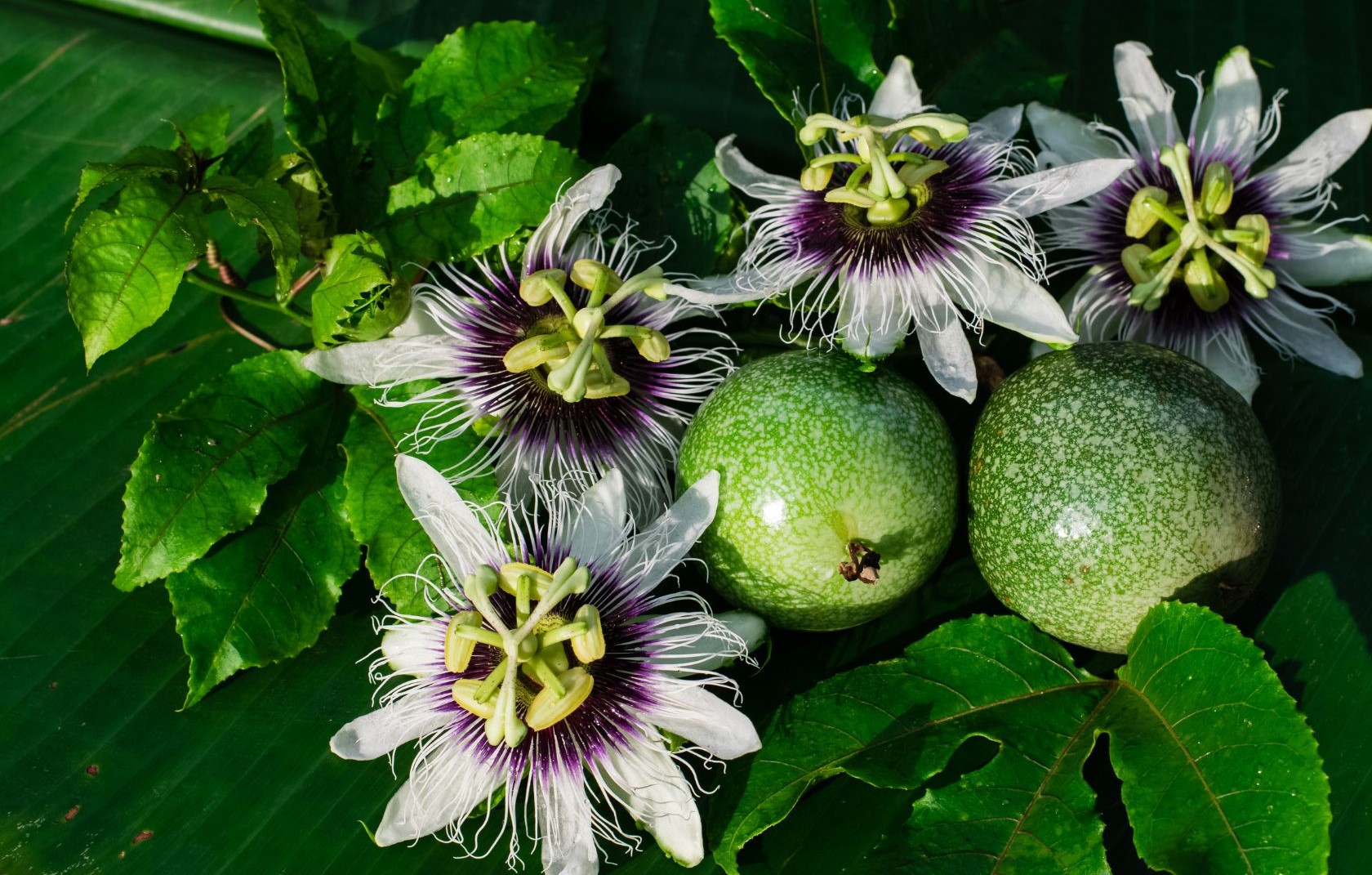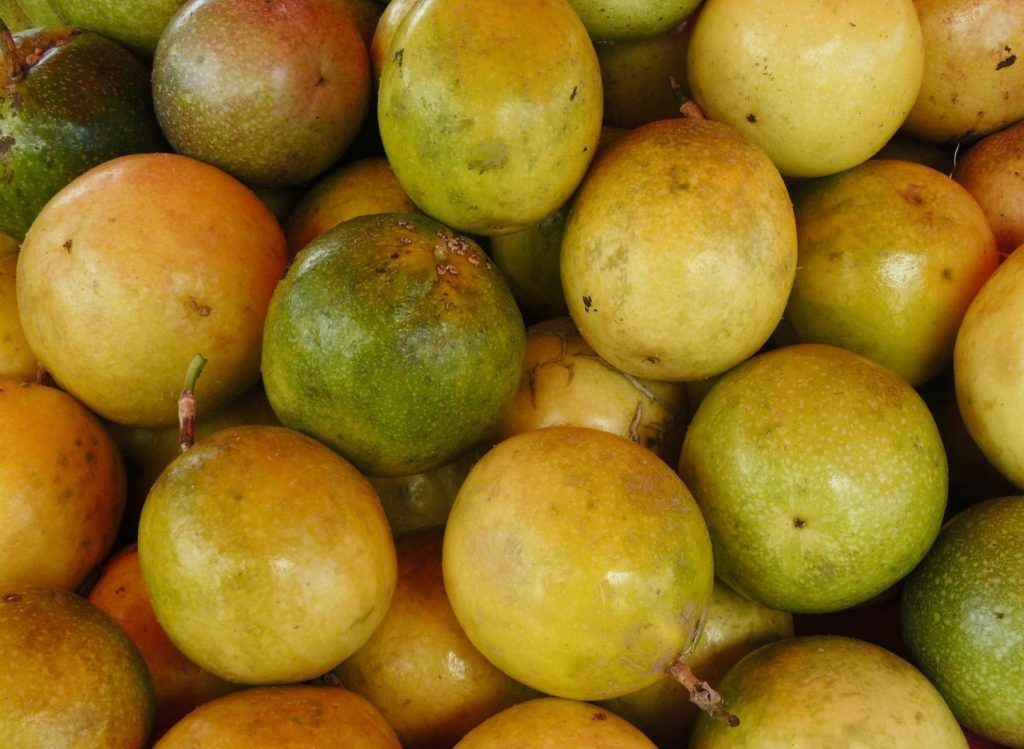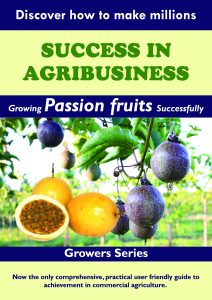Passion fruit: Types-Varieties of Passion Fruit and Plant Characteristics

This post is also available in:
This post is also available in:
![]() Deutsch (German)
Deutsch (German) ![]() हिन्दी (Hindi)
हिन्दी (Hindi) ![]() Ελληνικά (Greek)
Ελληνικά (Greek) ![]() Português (Portuguese (Brazil))
Português (Portuguese (Brazil))
Plant Information and Morphology of Passion Fruit
The Passion Fruit (Passiflora edulis of the Passifloraceae family) is a woody perennial, evergreen, fast-growing climber vine that has 2 main types: the purple (Passiflora edulis) or the yellow (Passiflora edulis flavicarpa) passion fruit.
The passion fruit plant has tri-lobed, glossy leaves 10-18 cm (4-7 in.) long with finely-toothed margins and alternate arrangement. The fruit starts to mature about 80 days after flowering during the warmest months of the year (summer to fall). The passion fruit vine has shallow roots, a woody structure, and the ability to climb using tendrils. The vines can grow up to 15 feet long.
Fruit: The fruit of both types is considered climacteric with high ethylene production.
The purple passion fruit plant bears dark-purple or nearly black, rounded, or egg-shaped fruit about 5 cm long, weighing 30-45 g.
Fruit of the yellow passion fruit is deep yellow and similar in shape but slightly longer (6 cm) and larger than the purple type. It weighs 60-90 g and averages about 75 g.
The fruit itself is nearly round or ovoid, measuring 1 1/2 to 3 inches (4-7.5 cm) in width. It has a tough, thick rind that is smooth and waxy, surrounding a layer of white pith.
Inside the fruit, there is a cavity that encloses up to 250 small, wedge-shaped black seeds. Each seed is surrounded by a deep orange-colored sac, which holds the juicy and consists of the edible part of the fruit. The flavor of the fruit is appealing, with musky and guava-like notes, and it ranges from subacid to acid in taste.
Flowers: Passion fruit has some of the most characteristic and spectacular flowers, making it a very popular plant for aesthetic reasons and widely used as an ornamental plant. The flowers resemble a clock, are white and purple-blue (especially in the center), have five petals, three large, green, leaf-like bracts, and a diameter of approximately 4.5-6 cm, depending on the type of passion fruit. Additionally, the flower consists of five stamens with large anthers, an ovary, and a triple-branched style that forms a prominent central structure.
Pollination is essential for fruit production on passion vines. Flowers of the purple passion vine normally set fruit when self-pollinated. Still, many yellow passion vines will only set fruit if their flowers are dusted with pollen from a different vine that is genetically compatible. Passion requires mild temperatures for normal fruiting and may flower but set no fruit (or misshapen fruit) during the hottest part of the hot season. The most effective insect for pollinating passion fruit is the bee. The native bee population may ensure adequate pollination and fruit naturally.
Yellow passion fruit flowers are perfect but self-sterile. In crossing the yellow and purple forms, it is necessary to use purple as the seed parent due to compatibility (it does not work the other way round.
Passion Fruit Types
The Passiflora genus, to which passion fruit belongs, has a great biodiversity numbering approximately 520 species. However, the commercial production of passion fruit is based on limited species and more specifically, the:
- the purple (Passiflora edulis)
- the yellow (Passiflora edulis flavicarpa) passion fruit
Some other important types are the sweet granadilla (Passiflora ligularis), and the giant granadilla (Passiflora quadrangularis L.)
The Yellow variety of the passion fruit
The yellow variety of the passion fruit vine exhibits a more robust vine and typically produces larger fruits, with more juice (31-35%) and higher yields compared to the purple variety. Plants of this type thrive mostly in low altitudes with tropical climates. At the same time, yellow-type passion fruits have higher tolerance and resistance to soil-born pests (like nematodes) and diseases (like leaf spot and wilt) compared to purple-type. This is the reason why yellow passion fruit is usually preferred as a rootstock.

The Purple passion fruit type
On the other hand, the purple passion fruit type is more suitable for sub-tropic conditions because it is sensitive to low temperatures and has moderate vigor. When it comes to pulp, the purple variety fruits are preferred by consumers due to the higher quality (lower acidity, stronger aroma, and flavor). The purple form of passion fruit has black seeds, while the yellow form has brown seeds.
With the aim of combining the best characteristics of each passion fruit type, scientists and breeders have crossed them and obtained a series of hybrids with superior yield, good disease resistance, and quality. Some hybrids with high commercial importance are the Kaveri in India, the “Redlands Triangular” and “Selection E23 from Australia and the Noel’s Special” from Hawaii.
In Kenya, locally selected purple passion fruit is vegetatively propagated for commercial production by KALRO (Kenya Agricultural and Livestock Research Organization), Jomo Kenyatta University, and other sources.
When selecting a passion fruit variety to plant and cultivate, the farmer should take into account important factors like the adaptability of the variety to the local environmental conditions, the field location, the intended market, and the availability of resources (labor, water, pesticides, etc.).
Type and Size of Planting Stock
The type of rootstock—standard, dwarf, or semi-dwarf—will determine the size of the tree at maturity. Standard trees produce more fruit when mature, and initial purchase and planting costs are lower. Smaller trees have higher initial planting costs since more trees are needed to achieve density. Dwarf and semi-dwarf trees generally come into production earlier. Smaller trees simplify many field operations, including pruning, grafting, thinning, pest management, and harvest. Efficiency and safety are greater when most operations can be accomplished from the ground as opposed to on ladders or by climbing. Depending on the species and variety, container seedlings are often the most practical form of planting stock to buy and the most economical to purchase.
References
- https://www.growables.org/information/TropicalFruit/Passionfruit.htm
- https://naads.or.ug/passion-fruit-production/
- https://ufdcimages.uflib.ufl.edu
- https://prsvkm.kau.in/book/
- https://pdf.usaid.gov/pdf_docs/PA00KC9Z.pdf
- Knight, R. J., Jr. and J. W. Sauls. 1994. The Passion Fruit. HS60. Gainesville: University of Florida Institute of Food and Agricultural Sciences.
- https://edis.ifas.ufl.edu/publication/HS1406
- https://agritech.tnau.ac.in/banking/pdf/Passion%20Fruit.pdf
- https://www.researchgate.net/

Further reading
- Passion Fruit: History, Uses and Nutritional value
- Passion fruit: Types-Varieties of Passion Fruit and Plant Characteristics
- Passion Fruit: Soil & Climate Requirements, Land Preparation and Planting
- Propagation and Trellising of Passion Fruit plants
- Training and Pruning of Passion Fruit Plant
- Passion Fruit Plant Care: Irrigation and Fertilization of Passion Fruit
- Important Passion Fruit Diseases
- Important Passion Fruit Pests
- Passion Fruit: Harvest, Yield and Storage








































































